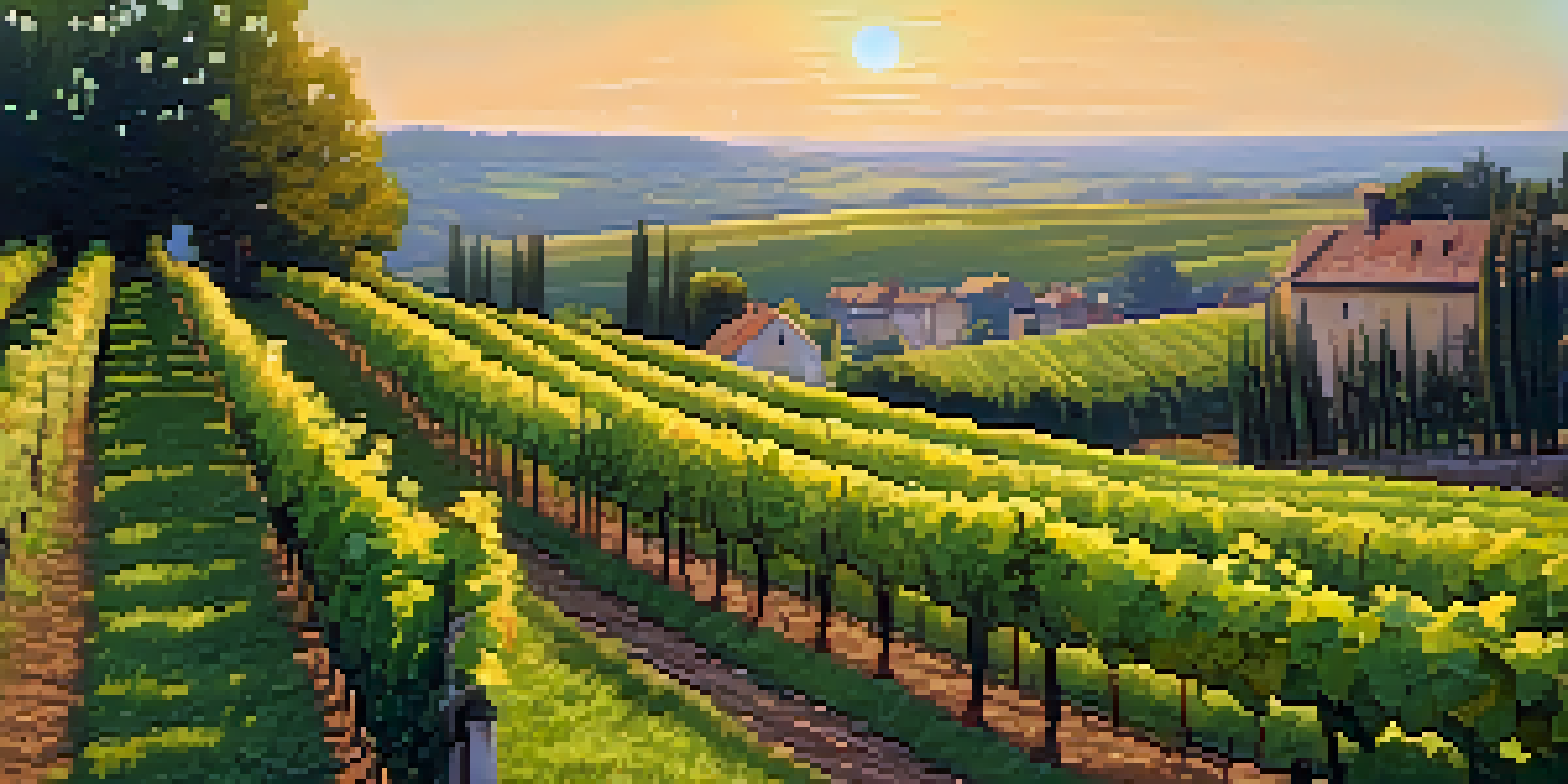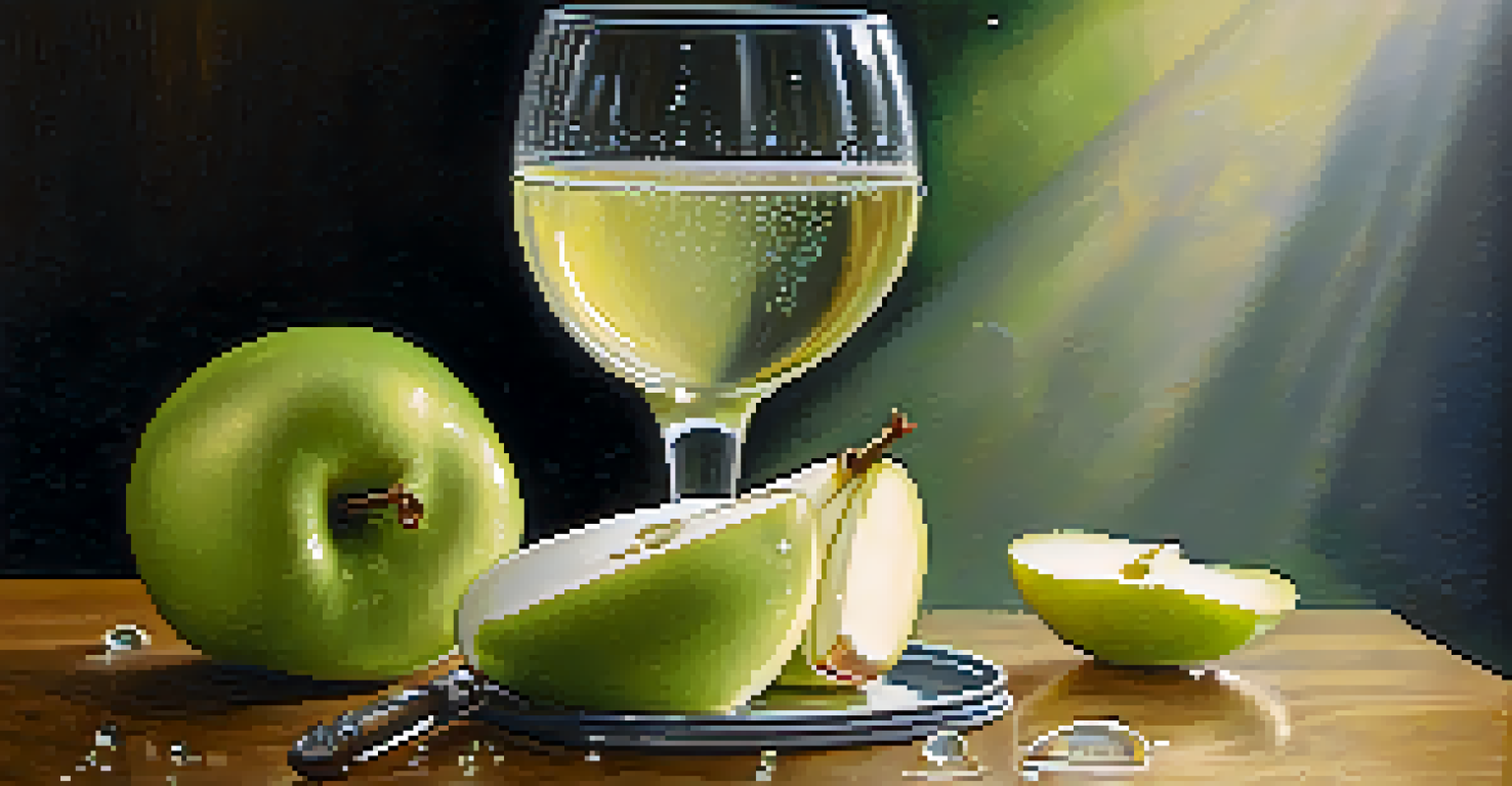The Essence of Chardonnay: A Tour of Global Wine Regions

Chardonnay: The Versatile Grape Behind Iconic Wines
Chardonnay is a remarkable grape that adapts beautifully to different climates and winemaking techniques. This versatility allows winemakers to create a wide range of styles, from crisp and refreshing to rich and buttery. Originating from Burgundy, France, Chardonnay has spread its roots worldwide, captivating wine lovers with its unique flavor profiles.
Wine is sunlight, held together by water.
What makes Chardonnay particularly intriguing is its ability to express the terroir—essentially the environmental factors that affect how the grapes grow. In cooler climates, like Chablis, it offers vibrant acidity and minerality, while warmer regions, such as Napa Valley, yield lush, tropical fruit flavors. Each bottle tells a story of its origin, which is part of its charm.
As you explore the world of Chardonnay, you'll discover that it's not just a wine; it's a journey through diverse landscapes and cultures. Whether you're sipping a glass at a café in Paris or a vineyard in Australia, Chardonnay connects you to its origins in a truly delightful way.
Unveiling Burgundy: The Heart of Chardonnay Production
Burgundy, France, is often regarded as the spiritual home of Chardonnay, where the grape thrives in its ideal conditions. The region's limestone-rich soils and temperate climate create the perfect environment for producing high-quality wines. Here, you'll find some of the most prestigious Chardonnay wines in the world, such as those from Meursault and Puligny-Montrachet.

In Burgundy, winemakers employ traditional methods, including barrel fermentation and aging, which add complexity and depth to the wine. The result is often a beautifully balanced Chardonnay, showcasing notes of green apple, pear, and subtle oak. Tasting a glass of Burgundy Chardonnay is akin to savoring a piece of history, as these vineyards have been cultivated for centuries.
Chardonnay's Global Versatility
Chardonnay adapts to various climates and winemaking styles, resulting in a wide range of flavor profiles from crisp to rich.
Visiting Burgundy feels like stepping into a wine lover's paradise, with picturesque vineyards and charming villages. Whether you're exploring the Côte d'Or or indulging in a wine tasting at a local domaine, the essence of Chardonnay is deeply woven into the fabric of this region.
California Dreaming: Chardonnay in the Golden State
California has emerged as a powerhouse for Chardonnay production, particularly in regions like Napa Valley and Sonoma County. The state's diverse climate allows winemakers to craft a wide range of styles, from bright and zesty to full-bodied and oaky. This versatility has made California Chardonnay a favorite among wine enthusiasts around the globe.
Good wine is a good familiar creature if it be well used.
In Napa Valley, Chardonnay often exhibits rich tropical fruit flavors, with notes of pineapple and mango, thanks to the warm climate. Many producers use oak aging to impart creamy textures and buttery notes, creating a luxurious mouthfeel. This style is quite different from the crisper Chardonnays found in cooler regions, showcasing the grape's adaptability.
Wine country in California is not just about tasting; it's an experience that combines stunning landscapes and gourmet food. A visit to a Napa vineyard can leave you with unforgettable memories, making it a must for any Chardonnay lover.
Australia: A New World Perspective on Chardonnay
Australia has gained recognition for its unique approach to Chardonnay, particularly from regions like Margaret River and Adelaide Hills. The country's diverse climates and innovative winemaking techniques result in expressive wines that often surprise those who associate Chardonnay with traditional methods. Here, you'll find exciting variations that showcase the grape's potential.
In Margaret River, for example, the cool ocean breezes help to preserve acidity, resulting in fresh and vibrant wines with citrus and stone fruit flavors. On the other hand, Adelaide Hills produces Chardonnays that often display a more elegant style, with delicate floral notes and minerality. This diversity makes exploring Australian Chardonnays a delightful adventure.
Burgundy: The Chardonnay Epicenter
Burgundy, France, is renowned for producing some of the highest quality Chardonnays, thanks to its ideal terroir and traditional winemaking methods.
The Australian wine scene is vibrant and welcoming, often featuring up-and-coming winemakers eager to share their passion. Tasting Chardonnay in Australia feels like a celebration of innovation and tradition, making it a thrilling destination for any wine aficionado.
Chardonnay in South America: A Rising Star
In recent years, South America has started to make its mark on the global Chardonnay scene, with Chile and Argentina leading the charge. The unique terroirs found in these countries contribute to the production of exciting and diverse Chardonnay wines. As winemakers experiment and innovate, the world is beginning to take notice of their offerings.
Chile, particularly the Casablanca Valley, is known for its cool temperatures and coastal influences, resulting in crisp and aromatic Chardonnays. These wines often feature bright acidity and flavors of citrus and green apple. Meanwhile, Argentina's high-altitude vineyards, such as those in Mendoza, produce rich and full-bodied Chardonnays that showcase tropical fruit flavors and a round mouthfeel.
As South American Chardonnay gains recognition, it invites wine lovers to discover new favorites. Exploring these regions can be a delightful journey, revealing the rich culture and tradition behind each bottle.
The Influence of Climate on Chardonnay's Flavor Profile
Climate plays a crucial role in shaping the flavor profile of Chardonnay. Grapes grown in cooler climates tend to have higher acidity and more mineral notes, while those in warmer regions often develop lush fruit flavors and fuller bodies. This relationship between climate and taste makes each Chardonnay unique to its origin.
During ripening, temperature fluctuations can also impact the wine's balance. For instance, cooler nights can help maintain acidity, leading to a fresher tasting wine. Conversely, consistent warm temperatures can lead to overripe flavors, resulting in a heavier style of Chardonnay. Understanding these nuances can enhance your appreciation for the wine.
Emerging Regions for Chardonnay
Countries like Australia and South America are innovating Chardonnay production, offering exciting new expressions that surprise traditional wine enthusiasts.
As climate change continues to affect wine regions worldwide, the flavors of Chardonnay may evolve. Observing these changes can be fascinating, as it may lead to new expressions of this beloved grape, reminding us of the dynamic nature of winemaking.
Pairing Chardonnay: A Culinary Adventure
One of the joys of Chardonnay is its versatility when it comes to food pairings. Whether you're enjoying a crisp Chablis or a rich Napa Valley Chardonnay, there's likely a dish that complements its flavors beautifully. The key is to consider the wine's body and flavor profile when selecting your meal.
For lighter, unoaked Chardonnays, consider pairing with seafood, salads, or light pasta dishes. The bright acidity enhances the freshness of these foods, creating a delightful balance. On the other hand, richer, oaked Chardonnays pair wonderfully with creamy pasta, roasted chicken, or even grilled lobster, as the wine's buttery notes harmonize with the dish.

Exploring Chardonnay through food pairing can be a fun and delicious experience. Whether hosting a dinner party or enjoying a quiet night in, experimenting with different combinations can lead to delightful discoveries that enhance both the wine and the meal.
Conclusion: The Timeless Allure of Chardonnay
Chardonnay continues to enchant wine lovers around the world with its remarkable versatility and diverse expressions. From the historic vineyards of Burgundy to the innovative wineries of Australia and South America, this grape tells a story of terroir, tradition, and creativity. Each bottle is a reflection of its origins, inviting us to explore the complexities of the world of wine.
As you embark on your Chardonnay journey, remember that every sip has a story to tell. Whether you're a seasoned connoisseur or just beginning to explore, there's always something new to discover in the world of Chardonnay. Its adaptability and charm make it a timeless classic that can suit any occasion.
So, raise your glass and toast to Chardonnay—an enduring favorite that connects us to diverse cultures and culinary experiences. With every bottle, we celebrate not just the wine itself, but the journey it represents.